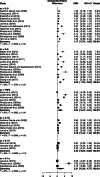Salivary cytokines as biomarkers of oral cancer: a systematic review and meta-analysis
- PMID: 33639868
- PMCID: PMC7912500
- DOI: 10.1186/s12885-021-07932-3
Salivary cytokines as biomarkers of oral cancer: a systematic review and meta-analysis
Abstract
Background: Oral cancer (OC) is usually diagnosed at advanced clinical stages due to its asymptomatic nature and absence of pathognomonic signs in its early development phase. Delayed diagnosis is one of the major causes of OC treatment failure and poor prognosis. Development of alternative diagnostic approaches are imperative for improving early detection and therapeutic success rates. Salivary cytokines (SC) have been studied as potential diagnostic biomarkers for OC and may represent a potential tool for improvement of its early detection.
Methods: In this systematic review and meta-analysis we identified SC studied as OC biomarkers by systematically reviewing the PubMed and Cochrane Library databases using the terms: "oral cancer", "cytokine", and "saliva", and also combined with "interleukin" or "interferon". Only case-control studies that measured SC by ELISA from treatment naïve patients were included in the qualitative review. For the meta-analysis were included all comparable studies that provided enough data (sample size, mean and standard deviation or standard error of the mean) for SC levels in OC patients, non-cancer controls and patients with oral potentially malignant disorders (OPMD), including leukoplakia. Comparisons with patients with oral lichen planus (OLP) and gingivitis were included in the qualitative analysis.
Results: A total of 28 articles (from 2004 to 2018) were included in the systematic review, describing 10 different SC, being IL-8 and IL-6 the most studied ones. SC levels were consistently higher among OC patients when compared to healthy controls and to patients with OPMD, OLP and gingivitis. Meta-analysis including 23 eligible studies showed that IL-8, IL-6, TNF-α, IL-1β and IL-10 salivary levels were significantly higher in OC patients compared to controls; and that IL-8, IL-6, TNF-α and IL-1β salivary levels were also higher in OC patients compared to individuals with OPMD. When compared to healthy controls, OPMD patients showed significantly higher IL-6 and TNF-α salivary levels.
Conclusions: Our analyses showed that the salivary levels of some cytokines are consistently different among OC, OPMD and healthy patients, indicating that these SC may represent potential diagnostic biomarkers for OC and OPMD. Despite of that, SC levels were highly variable among studies, suggesting that further technical improvement and standardization for SC measurement by ELISA is needed in order to successfully translate these biomarkers to the clinical practice.
Keywords: Biomarkers; Cytokines; Head and neck cancer; Oral cancer; Saliva.
Conflict of interest statement
The authors declare that they have no conflict of interest.
Figures




Similar articles
-
Salivary Lactate Dehydrogenase as a Potential Biomarker in Oral Potentially Malignant Disorders and Head & Neck Cancer- A Systematic Review and Meta-analysis.Gulf J Oncolog. 2023 Jan;1(41):78-99. Gulf J Oncolog. 2023. PMID: 36804163
-
Identification of common salivary miRNA in oral lichen planus and oral squamous cell carcinoma: systematic review and meta-analysis.BMC Oral Health. 2024 Oct 4;24(1):1177. doi: 10.1186/s12903-024-04986-0. BMC Oral Health. 2024. PMID: 39367474 Free PMC article.
-
Salivary KLK5 and uPA are potential biomarkers for malignant transformation of OLK and OLP.Cancer Biomark. 2021;31(4):317-328. doi: 10.3233/CBM-203105. Cancer Biomark. 2021. PMID: 33896830
-
Serum and salivary interleukin-1β level in oral precancer: An observational study.J Cancer Res Ther. 2024 Apr 1;20(3):788-792. doi: 10.4103/jcrt.jcrt_2107_22. Epub 2023 May 2. J Cancer Res Ther. 2024. PMID: 39023584
-
Role of selected salivary inflammatory cytokines in the diagnosis and prognosis of oral squamous cell carcinoma. A Systematic Review and Meta-analysis.Med Oral Patol Oral Cir Bucal. 2023 Sep 1;28(5):e474-e486. doi: 10.4317/medoral.25889. Med Oral Patol Oral Cir Bucal. 2023. PMID: 37099710 Free PMC article.
Cited by
-
Diagnostic Accuracy of Liquid Biopsy for Oral Potentially Malignant Disorders and Head and Neck Cancer: an Overview of Systematic Reviews.Curr Oncol Rep. 2023 Apr;25(4):279-292. doi: 10.1007/s11912-023-01365-w. Epub 2023 Feb 15. Curr Oncol Rep. 2023. PMID: 36790668
-
Oral and Gingival Crevicular Fluid Biomarkers for Jawbone Turnover Diseases: A Scoping Review.Diagnostics (Basel). 2024 Sep 30;14(19):2184. doi: 10.3390/diagnostics14192184. Diagnostics (Basel). 2024. PMID: 39410587 Free PMC article.
-
Induction of Collagenolytic MMP-8 and -9 Tissue Destruction Cascade in Mouth by Head and Neck Cancer Radiotherapy: A Cohort Study.Biomedicines. 2023 Dec 21;12(1):27. doi: 10.3390/biomedicines12010027. Biomedicines. 2023. PMID: 38275388 Free PMC article.
-
Expression of Interleukin-1ß and Interleukin-8 in Oral Potentially Malignant Disorders and Carcinomas.Front Oral Health. 2021 Sep 10;2:649406. doi: 10.3389/froh.2021.649406. eCollection 2021. Front Oral Health. 2021. PMID: 35048001 Free PMC article.
-
Salivary EGF: EGFR ratio as potential early diagnostic biomarker for oral cancer detection in tobacco chewers: a preliminary cross-sectional study.BMC Oral Health. 2025 Apr 29;25(1):663. doi: 10.1186/s12903-025-05982-8. BMC Oral Health. 2025. PMID: 40301868 Free PMC article.
References
-
- Amit M, Yen TC, Liao CT, Binenbaum Y, Chaturvedi P, Agarwal JP, et al. Clinical nodal stage is a significant predictor of outcome in patients with oral cavity squamous cell carcinoma and pathologically negative neck metastases: results of the international consortium for outcome research. Ann Surg Oncol. 2013;20:3575–3581. doi: 10.1245/s10434-013-3044-0. - DOI - PubMed
-
- Curado MP, Johnson NW, Kerr AR, Pereira L, Mendonc DR, Lanfranchi H. Oral and oropharynx cancer in South America : Incidence , mortality trends and Oral and oropharynx cancer in South America : Incidence , mortality trends and gaps in public databases as presented to the Global Oral Cancer Forum. Transl Res Oral Oncol. 2016;1:1–7.
Publication types
MeSH terms
Substances
LinkOut - more resources
Full Text Sources
Other Literature Sources
Medical

